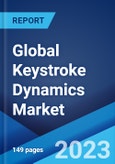Keystroke dynamics is a behavioral biometric used for the authorization and authentication of the typing activities on the keyboard. It analyzes the rhythm pattern, variations in speed and common errors of the individual while typing. It utilizes static and dynamic technology for verification. The static technology analyzes the keystroke patterns only at specific times, such as during login, whereas the dynamic technology offers continuous verification throughout the duration of interaction with the device. The measurements are further used for analyzing the dwell and flight time of the user. Keystroke dynamics are also widely used with mouse movement trackers for multifactor authentication, surveillance and monitoring the access of confidential and sensitive documents through acceleration time and click frequency.
Keystroke Dynamics Market Trends
The rising incidence of cybercrimes and fraudulent digital transactions across the globe is one of the key factors driving the growth of the market. Various industries, such as banking, financial services and insurance, retail, healthcare, education and defense, are widely adopting keystroke dynamics for multimodal biometrics and safeguarding critical information. Additionally, various technological advancements, such as the integrations of security systems with the Internet of Things (IoT), machine learning (ML) and cloud-computing solutions, are acting as other growth-inducing factors. Keystroke dynamics are combined with pattern authentication systems to provide a user-friendly experience and enhanced security to the organization. In line with this, cloud computing integrated keystroke dynamic solutions are also extensively used for remote and automatic user authentication and enhanced performance and interoperability. Other factors, including the widespread adoption of smartphones and other smart devices, along with significant improvements in the information technology (IT) infrastructure, are anticipated to drive the market toward growth.Key Market Segmentation
This research provides an analysis of the key trends in each sub-segment of the global keystroke dynamics market report, along with forecasts at the global, regional and country level from 2023-2028. The report has categorized the market based on component, authentication type, deployment model, application, organization size and end user.Breakup by Component:
- Software
- Service
Breakup by Authentication Type:
- Static Authentication
- Continuous Authentication
Breakup by Deployment Model:
- On-premises
- Cloud-based
Breakup by Application:
- Identity Proofing
- Continuous Authentication
- Risk and Compliance Management
- Fraud Detection and Prevention
Breakup by Organization Size:
- Large Enterprises
- Small and Medium Enterprises
Breakup by End User:
- BFSI
- Retail and E-Commerce
- Healthcare
- Government and Defense
- Education
Breakup by Region:
- North America
- United States
- Canada
- Asia-Pacific
- China
- Japan
- India
- South Korea
- Australia
- Indonesia
- Europe
- Germany
- France
- United Kingdom
- Italy
- Spain
- Russia
- Latin America
- Brazil
- Mexico
- Middle East and Africa
Competitive Landscape
The competitive landscape of the industry has also been examined along with the profiles of the key players being AuthenWare Corporation, BehavioSec Inc. , Daon Inc., Deepnet Security, Delfigo Security, ID Control BV, Intensity Analytics Corporation, KeyTrak Inc, Serban Biometrics and TypingDNA.Key Questions Answered in This Report:
- How has the global keystroke dynamics market performed so far and how will it perform in the coming years?
- What has been the impact of COVID-19 on the global keystroke dynamics market?
- What are the key regional markets?
- What is the breakup of the market based on the component?
- What is the breakup of the market based on the authentication type?
- What is the breakup of the market based on the deployment model?
- What is the breakup of the market based on the application?
- What is the breakup of the market based on the organization size?
- What is the breakup of the market based on the end user?
- What are the various stages in the value chain of the industry?
- What are the key driving factors and challenges in the industry?
- What is the structure of the global keystroke dynamics market and who are the key players?
- What is the degree of competition in the industry?
Table of Contents
Companies Mentioned
- AuthenWare Corporation
- BehavioSec Inc.
- Daon Inc.
- Deepnet Security
- Delfigo Security
- ID Control BV
- Intensity Analytics Corporation
- KeyTrak Inc
- Serban Biometrics
- TypingDNA
Methodology

LOADING...
Table Information
| Report Attribute | Details |
|---|---|
| No. of Pages | 149 |
| Published | November 2023 |
| Forecast Period | 2022 - 2028 |
| Estimated Market Value ( USD | $ 390.6 Million |
| Forecasted Market Value ( USD | $ 1413.1 Million |
| Compound Annual Growth Rate | 23.9% |
| Regions Covered | Global |
| No. of Companies Mentioned | 10 |









